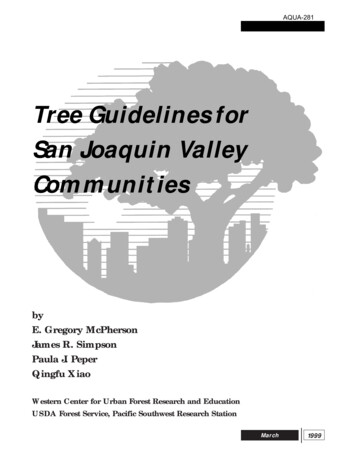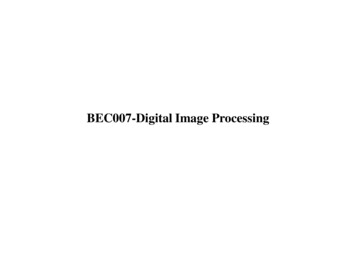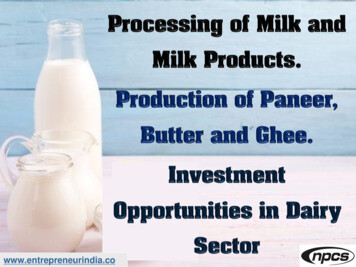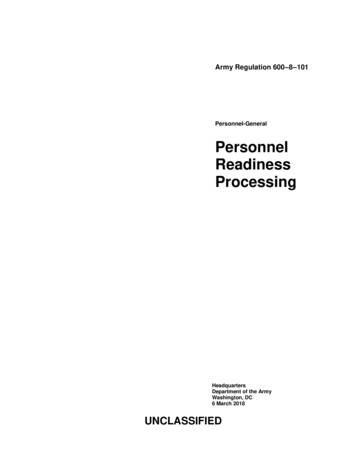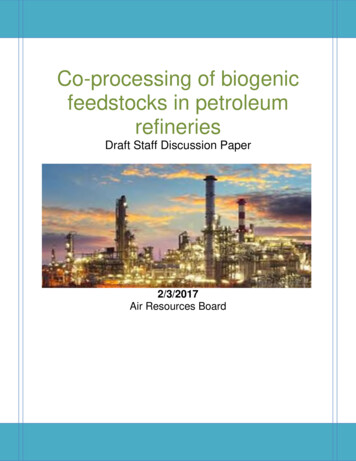
Transcription
Co-processing of biogenicfeedstocks in petroleumrefineriesDraft Staff Discussion Paper2/3/2017Air Resources Board
DraftContents1.Introduction . 32.Objectives . 23.Literature Review . 23.1.Co-processing . 23.1.1. Co-processing of Pyrolysis Oil in a typical FCC Unit . 33.1.2. Co-processing of Lignin and Glycerol in a typical FCC unit . 63.1.3. Co-processing of Triglycerides (vegetable oil and animal fat) . 73.2Co-processing in hydrotreaters . 84.Issues related to co-processing. 105.Co-processing Potential in California . 116.Approaches to Renewable Content Quantification. 126.1.C14 isotopic method . 136.2.Total mass balance approach. 136.2.1. Other mass balance approaches. 156.3.7.Biogenic feedstock energy content method . 16Proposed LCA Methodology for Co-processing . 177.1.Default value approach. 177.2.Process unit level estimation . 187.2.1. Energy content–based allocation. 187.2.2. Hybrid marginal allocation . 208.Monitoring and verification . 219.Summary. 21i
DraftList of FiguresFigure 1. A schematic of an FCC unit for co-processing . 5Figure 2. Product yield trends at various bio-oil to VGO ratios (source: Lindfors et al,2015) . 6Figure 3. Product outputs from catalytic cracking as a function of feedstock composition. 8Figure 4. Schematic of co-processing in a hydrotreater . 10Figure 5 Illustration of total mass balance analysis (tpd ton per day). 14Figure 6. LCA system boundary for co-processing. 17Figure 7. Process level energy inputs, outputs and CO2 emissions for illustratingprocess unit level energy and CO2 allocation. 18Figure 8. Illustration of process unit level allocation . 19Figure 9. Illustration of the hybrid marginal approach . 21List of TablesTable 1. Typical chemical and physical properties of biogenic feedstocks summarizedfrom various sources . 4Table 2. Impact of upgrading of pyrolysis oil on liquid product yields . 6Table 3. Co-processing capacity and renewable hydrocarbon fuel production potential inCalifornia Refineries . 12Table 4. Chemical composition analysis of feedstocks . 14Table 5. Estimation of renewable mass of co-processed products (10% pyrolysis oil 90% VGO example) . 15ii
Draft1. IntroductionCo-processing refers to the simultaneous transformation of biogenic feedstocks andintermediate petroleum distillates such as vacuum gas oil (VGO) in existing petroleum refineryprocess units to produce renewable hydrocarbon fuels. Co-processing has recently receivedattention due to its potential to provide low carbon renewable fuels at economically competitiveprices by utilizing existing refining, transport and storage infrastructure. Several entitiesincluding national labs and universities are involved in co-processing research anddevelopment, and a few commercial refiners are exploring both pilot and commercialproduction.Current research is mostly directed at the potential of fluid catalytic cracking (FCC) andhydrocracking/hydrotreating units in refineries for co-processing. Research to date suggeststhat co-processing of up to 20 percent (wt.) biogenic oils with VGO may be possible in FCCunits1. The US Department of Energy estimates that more than 8 billion gallons of renewablehydrocarbon fuels could potentially be produced from co-processing in 110 FCC units in theUSA.2Air Resources Board (ARB) staff recognize the potential of co-processing to produce low carbonhydrocarbon fuels in-state. With no blending constraints and the ability to use existing fueltransport and distribution infrastructure, co-processed fuels offer a significant opportunity tocontribute to the 10 percent reduction in the carbon intensity of transportation fuels under theLow Carbon Fuel Standard (LCFS) program. In addition, with the adoption of SB323 in 2016,staff is considering additional reductions from this program through 20304. To incentivize thecommercial production of co-processed fuels, a technical work group established by staff isexploring technical and logistical aspects related to co-processing operations and finished fuelproduction in-state. The work group includes invited technical experts (from NationalLaboratories, Universities and Technology companies) together with stakeholders representingoil companies, other fossil industries, co-processing technology companies, co-processingfeedstock producers, and environmental NGOs. Because the primary focus of the LCFSprogram is the reduction of life-cycle greenhouse gas (GHG) emissions from transportationfuels, the work group efforts are focused on the technical issues related to the quantification ofrenewable fuel volumes from co-processing in petroleum refineries. In addition, since creditsare generated based on carbon intensity of co-processed streams, the work group will alsoevaluate lifecycle approaches to estimating greenhouse gas emissions for such fuels on a wellto-wheel basis.Research and exploratory work related to co-processing is a fairly new area, with the potentialto grow rapidly in the near future. Existing methods and guidelines used to estimate carbonintensities for renewable product streams are limited. Additionally, the biogenic fractions of the1Fogassy, Gabriella, et al. "Biomass derived feedstock co-processing with vacuum gas oil for secondgeneration fuel production in FCC units." Applied Catalysis B: Environmental 96.3 (2010): 476-485.2DOE. “New Pilot Plant Demonstrates the Potential to Co-Process Biomass Streams with Petroleum.”October 11, 2016. ov/faces/billNavClient.xhtml?bill id 201520160SB324ARB. The 2017 Climate Change Scoping Plan Update: The Proposed Strategy for AchievingCalifornia’s 2030 Greenhouse Gas Target. Scoping Plan Document. Sacramento: ARB, 2017.https://www.arb.ca.gov/cc/scopingplan/2030sp pp final.pdfiii
Draftco-processed liquid products and process unit emissions will be important to other ARBregulatory programs, including the Regulation for the Mandatory Reporting of Greenhouse GasEmissions (MRR) and the Cap-and-Trade Program. The primary objective of this draft whitepaper is to review and evaluate current industry and academic research related to coprocessing and details a few options for:a) the quantification of renewable content in produced fuels; andb) estimation of carbon intensities for renewable hydrocarbon fuelsThis paper also identifies additional technical issues that may need to be resolved (i.e., catalystdeactivation). As part of on-going stakeholder engagement, staff will explore operational,institutional and logistical challenges to sourcing and processing biogenic feedstocks in FCC,hydrocracking, and hydrotreating process units in commercial refineries.2. ObjectivesThe objectives of this paper are to: Identify and summarize existing research literature on co-processing;Identify advantages and issues related to co-processing;Describe a few renewable content quantification methodologies; andDetail a few Life Cycle Analysis methodologies for co-processing.3. Literature Review3.1.Co-processingCo-processing refers to the simultaneous transformation of biogenic feedstocks andintermediate petroleum products such as vacuum gas oil (VGO) in existing petroleum refineryprocess units to produce renewable hydrocarbon fuels. Co-processing involves cracking,hydrogenation, or other reformation of semi-processed biogenic oils, vegetable oils and fats incombination with petroleum intermediates to obtain finished fuels such as diesel, gasoline andjet fuels. Research literature suggests that co-processing may provide a significant pathway forutilizing existing refining infrastructure to process biomass, mainly lignocellulosic feedstocks,and increase the supply of drop-in biofuels to the market.5 Semi-processed biogenic feedstocksthat have been identified as likely to be suitable for co-processing include pyrolysis oil frompyrolysis, and triglycerides such as virgin vegetable oils, used cooking oils, and fat-based oils.In addition, lignin and sugars may be co-processed in existing refineries.Refining processes that could potentially be utilized for co-processing include (1) thermalcracking (visbreaking and coker unit), (2) catalytic cracking, (3) hydrotreating, and (4)hydrocracking. Thermal cracking of biogenic feedstocks results in products with high oxygencontent and is generally not considered practical for producing renewable diesel and gasoline.65Freeman, C., et al. "Initial assessment of US refineries for purposes of potential bio-based oilinsertions." (2013).6Melero, J. A., et al. "Production of biofuels via catalytic cracking." Handbook of biofuels production:processes and technologies (2011): 390-419.2
DraftOver the last decade, refiners have explored co-processing options mainly to evaluatecompliance scenarios related to biofuel and GHG reduction mandates in North America andEurope. Companies such as Chevron and Petrobras, and research organizations such asNational Renewable Energy Laboratory and Pacific Northwest National Laboratory are pursuingco-processing research and development efforts. A consortium consisting of Ensyn, Chevron,and Tesoro is investigating commercial scale co-processing of pyrolysis oil derived from forestresidues.Technologies and research outcomes associated with co-processing are described below.3.1.1. Co-processing of Pyrolysis Oil in a typical FCC UnitPyrolysis oil derived from either pyrolysis or liquefaction of biomass is made of severaloxygenated organic compounds including acids, aldehydes, ketones, alcohols, glycols, esters,phenols, carbohydrates, and lignin-based oligomers and water.6 Pyrolysis oil is reported tohave high oxygen content ranging from 8 to 63 percent (dry basis) depending on feedstocks andpyrolysis conditions,7 although typical values may range from 28 to 50 percent (Table 1). Thehigher oxygen content of pyrolysis oil is responsible for its lower stability, poor miscibility with oil,higher acidity and lower energy content. In comparison, triglycerides (vegetable oil and animalfat) have favorable chemical properties for co-processing such as lower oxygen content andnegligible water content. The energy content of raw pyrolysis oil is usually about half ofpetroleum fuels. An extensive literature review carried out by Gollakota et al.7 suggests thatenergy content of pyrolysis oil can vary from 8-37 MJ/kg (LHV) for lignocellulosic feedstocks,although typical values may range from 13 to 30 MJ/kg. Typical chemical and physicalproperties of pyrolysis oil and vegetable oil are shown in Table 1. For comparison, similarproperties for VGO and diesel oil are also included in Table 1.Co-processing in FCC units is a promising method of transforming pyrolysis oil into renewablegasoline and diesel fuels. Since most refineries in the U. S. are equipped with FCC units, theinfrastructure for co-processing pyrolysis oil already exist in the country. Figure 1 provides aschematic of a typical FCC process unit. The FCC unit provides an environment for crackingheavier molecular weight pyrolysis oil, as it is more selective and can be carried out undermilder reaction conditions. Catalytic cracking removes oxygen present in feedstocks in the formof water, CO and CO2 via simultaneous dehydration, decarboxylation, and decarbonylation. Coprocessing in an FCC unit has an advantage compared to other processing units in a refinerybecause additional hydrogen or energy inputs are typically not required, saving both costs andadditional GHG emissions.7Gollakota, Anjani RK, et al. "A review on the upgradation techniques of pyrolysis oil." Renewable andSustainable Energy Reviews 58 (2016): 1543-1568.3
DraftTable 1. Typical chemical and physical properties of biogenic feedstocks summarizedfrom various sourcesFuel PropertyoDensity@ 15 CKinematicoviscosity@50 CLower heating valueAshWater contentElemental table9oil0.9-0.93o 38 at 40 CVacuumgas oil1.22Diesel oilkg/LCPPyrolysis8oil1.05-1.2540-100MJ/kg% wt.% wt.13-30 0.215-3036-37 0.01 0.07542 1%42.9 0.010.1% wt.% wt.% wt.% wt.% wt.55-655-728-54 0.05 0.4 80 12 .80.90.15-0.30The final makeup of products from co-processing is determined by feedstock type and reactionconditions. Cracking at an FCC unit is carried out at temperatures ranging from 350-500oC andone atmosphere of pressure in the presence of zeolite catalysts. Studies have shown that aportion of pyrolysis oil ends up as coke, petroleum gases (LPG), CO2, CO, and water.11 This isattributed to lower thermal stability of pyrolysis oil, resulting in the formation of larger amounts ofcoke, CO2, CO, and LPG, compared to cracking VGO alone. Due to higher oxygen content ofpyrolysis oil, more water is also produced during the reaction, compared to the processing ofVGO only. In-addition, co-processing of pyrolysis oil in FCC units results in higher amounts ofoxygenated and phenolic compounds in liquid products.Recently, a pilot scale study by Pinho et al.11 utilized a tracer technique (C14) to quantify therelative proportion of pyrolysis oil-originating products in a pilot scale FCC unit. The studyrevealed that 30 percent of renewable carbon in pyrolysis oil would end up in total liquidproducts (gasoline, light cycle oil (LCO) and bottoms). This suggests that an appreciableamount of carbon in pyrolysis oil ends up as LPG, coke, CO, and CO2, thereby reducing overallliquid product yields. These results are consistent with yield trends (Figure 2) reported byLindfors et al. which show that as the mass percent of pyrolysis oil feedstock increases, yieldsof gases and coke also increase, which come at the expense of lower liquid fuel yields.128Vivarelli, Silvia, and Gianluca Tondi. "Pyrolysis oil: an innovative liquid biofuel for heating The COMBIOProject." International Workshop. Bioenergy for a sustainable development, Casino Vin a del Mar e Chile.2004.9Toscano, Giuseppe, and Eleonora Maldini. "Analysis of the physical and chemical characteristics ofvegetable oils as Fuel." Journal of Agricultural Engineering 38.3 (2007): 39-47.10Chen, Jinwen, Hena Farooqi, and Craig Fairbridge. "Experimental study on co-hydroprocessing canolaoil and heavy vacuum gas oil blends." Energy & Fuels 27.6 (2013): 3306-3315.11Pinho, Andrea de Rezendo et al. "Co-processing raw bio-oil and gasoil in an FCC unit." FuelProcessing Technology 131 (2015): 159-166.12Lindfors, Christian, et al. "Co-processing of Dry Bio-oil, Catalytic Pyrolysis Oil, and Hydrotreated Bio-oilin a Micro Activity Test Unit." Energy & Fuels 29.6 (2015): 3707-3714.4
DraftPyrolysis oilVacuum gas oil(VGO)Figure 1. A schematic of an FCC unit for co-processing11Previous pilot-scale studies suggest carbon conversion efficiencies in the range of15-20 percent.11 However, the conversion efficiency of pyrolysis oil to renewable diesel andrenewable gasoline, and coke formation behavior are expected to be different in commercialscale FCC plants. Pinho et al. pointed out that blending pyrolysis oil with VGO feed may not bepossible at a commercial scale FCC unit, due to excess polymerization in blends during storageand coke formation under FCC conditions.11 Hence, the study suggests that pyrolysis oil andVGO would need to be injected separately into a riser reactor at different heights, to increasethermal cracking and prevent these undesirable reactions.Research also demonstrates that it is possible to improve renewable gasoline yields to levelscomparable to that of 100 percent VGO, if raw pyrolysis oil is upgraded to hydrodeoxygenatedoil (HDO) and then co-processed with VGO. A study by Fogassy et al. simulating FCCconditions found that co-processing 20 percent HDO with 80 percent VGO resulted in gasolineyields comparable to that of the conventional FCC feedstock (VGO).1 Lower oxygen contentand higher aliphatic and aromatic content of HDO resulting from upgrading may have12contributed to improved gasoline yields. Similar results were reported by Lindfors et al. wherehydrogenated pyrolysis oil yielded 74% (by weight) liquid products compared to 69% for drypyrolysis oil (Table 2).5
DraftFigure 2. Product yield trends at various bio-oil to VGO ratios (source: Lindfors et al,2015)12Table 2. Impact of upgrading of pyrolysis oil on liquid product yields(Source: Lindfors et al.12)ProductsLiquid (wt. %)Gas (wt. %)Coke (wt.%)VGOVGO 20% drypyrolysis oil69141085105VGO 20% HDO7412103.1.2. Co-processing of Lignin and Glycerol in a typical FCC unitLignin: Co-processing of lignin in an FCC unit in the presence of zeolite catalysts and attemperatures 500-650oC produces liquid fuels primarily consisting of aromatic hydrocarbonssuch as toluene, benzene, and xylene.13 In addition CO, CO2, light hydrocarbon gases, water,and coke are produced. The lignin co-processing with VGO is shown to increase thecrackability of VGO and shift yields towards light end products. At a temperature of 500oC,about a 50 percent (by weight) conversion rate of lignin to coke and char has been reported.6The same study reports that at higher temperatures ( 650oC), the lignin conversion to cokedeclines to 25 percent.6 The high aromatic content in the liquid products (including renewablediesel) differentiates co-processing of lignin from pyrolysis oil. It is likely that the high coke yieldfrom lignin co-processing may make lignin unsuitable in a majority of FCC units.6Glycerol: Glycerol obtained from sugar fermentation and trans-esterification of vegetable oilsand fats can be co-processed with VGO in an FCC unit to obtain renewable diesel and gasoline.Depending on the types of catalyst used, glycerol co-processing provides different productyields. A ZSM-5 catalyst is shown to yield more olefins (unsaturated hydrocarbons such aspropene and butene) and aromatics but less than 20 percent coke. The use of other catalysts in13Thring, Ronald W., Sai PR Katikaneni, and Narendra N. Bakhshi. "The production of gasoline rangehydrocarbons from Alcell lignin using HZSM-5 catalyst." Fuel Processing Technology 62.1 (2000): 1730.6
Draftan FCC unit leads to higher levels of coke, in the range of 30-50 percent.14 Given that glycerolis currently an expensive feedstock, its use for co-processing may be limited.3.1.3. Co-processing of Triglycerides (vegetable oil and animal fat)As with co-processing of pyrolysis oil in FCC units, co-processing of triglycerides such asvegetable oil and animal fat with VGO in FCC units appears to be an attractive option. Unlike inthermal cracking, FCC catalysts remove oxygen from final products in the form of CO2, CO, andwater yielding products similar to processing 100 percent VGO in FCC units. Studies performedusing conditions that attempt to simulate FCC operating conditions have reported negligibleamounts of oxygenated hydrocarbons in the final products.15,16,17 Since triglycerides primarilycomprise paraffinic and olefinic hydrocarbons, the resulting product slate is likely to lead to anincreased amount of gasoline.Research carried out to date on co-processing of triglycerides with VGO under FCC conditionspoints to the following trends in the product outputs:15,18,19,20As the percentage of triglycerides in the co-processed mixture increases: The percentage of liquid products (gasoline, light cycle oil (LCO), and decanted oil (DO)in the final product slate declines. The percentage of light petroleum gas (LPG) increases. The higher yields of LPG anddry gases are attributed to better crackability of triglycerides as there are no aromaticsin triglycerides. The percentage of coke increases. This is because there is an accelerated removal ofhydrogen from hydrocarbon molecules in the presence of triglycerides. The percentage of CO and CO2 increases due to the presence of oxygen in the biogenicfeedstock. While polyaromatic content decreases, there is an increase in monoaromatic anddiaromatic content. Triglycerides have no monoaromatic and diaromatic compounds tobegin with but they are easily produced from triglycerides during co-processingThese trends are succinctly captured in Figure 3 which shows varying product outputs from coprocessing of palm oil (PO) with VGO under FCC conditions.14Corma, Avelino, et al. "Processing biomass-derived oxygenates in the oil refinery: Catalytic cracking(FCC) reaction pathways and role of catalyst." Journal of Catalysis 247.2 (2007): 307-327.15Melero, Juan A., et al. "Production of biofuels via the catalytic cracking of mixtures of crude vegetableoils and nonedible animal fats with vacuum gas oil." Energy & Fuels 24.1 (2009): 707-717.16Li, Hong, et al. "Enhancing the production of biofuels from cottonseed oil by fixed-fluidized bed catalyticcracking." Renewable Energy 34.4 (2009): 1033-1039.17Chew, Thiam Leng, and Subhash Bhatia. "Effect of catalyst additives on the production of biofuels frompalm oil cracking in a transport riser reactor." Bioresource technology 100.9 (2009): 2540-2545.18Pinho, A. D. R., et al. Catalytic Cracking Process and Catalysts for Production of Diesel Fuel from Pureand Waste Vegetable Oils. PBSA (Petrobras), Brazil, US 7176, 2007.19Bormann, K., H. Tilgner, and H-J. Moll. "Rape seed oil as a feed component for the catalytic crackingprocess." Erdol Erdgas Kohle 109 (1993): 172-172.20Buchsbaum, A., et al. The challenge of the biofuels directive for a European refinery. OMW Refiningand Marketing, ERTC 9th Annual Meeting, Prague, Czech Republic, Nov. 15-17, 2004.7
DraftFigure 3. Product outputs from catalytic cracking as a function of feedstockcomposition6Although co-processing of triglycerides in existing FCC units holds promise due to its beneficialproperties, such as lower oxygen content, higher hydrogen index, and similar physicalproperties to conventional feedstock in FCC units, it is still in the research and developmentphase. There has been a limited effort in co-processing of triglycerides under real FCCconditions at a pilot plant scale.6Currently, co-processing in FCC units is not being utilized on a commercial scale due toconcerns about feedstock stability during storage, and corrosiveness of biomass feedstockunder high temperatures. Refiners are also likely reluctant to take catalyst and runtime risksthat may result from co-processing such feedstocks in large processing units.63.2Co-processing in hydrotreatersCo-processing of biogenic feedstocks with petroleum distillate fractions is also possible inhydrotreating (HT) units. Triglycerides can be co-processed with middle distillates or VGO in8
Drafthydrotreaters.21,22 Typical catalysts used in hydrotreatment of triglycerides include CoMo/Al2O3and NiMo/Al2O3. Figure 4 illustrates the co-processing of triglyceride oils and diesel and jet fuelmiddle distillates in a hydrotreater. Plant oils and animal fats comprised primarily of triglyceridescan be converted to renewable diesel, renewable jet fuel, biopropane and renewable naphtha(which can be converted to gasoline) in the presence of hydrogen and catalysts and under mildtemperatures (300-350oC). Conversion occurs through decarboxylation, decarbonylation andhydro-deoxygenation reactions. During cracking of larger hydrocarbon molecules into lighterfuel fractions, small amounts of renewable naphtha and hydrocarbon gases such as biopropaneare also produced. Bio-propane can be used as a renewable and non-fossil input to therefinery’s fuel gas to provide heat to process units. In addition to hydrotreaters, hydrocrackersmay also be used for co-processing of triglycerides.Research provides good evidence of the technical and economic viability of hydrotreating oftriglyceride feedstocks on a commercial scale. Operating conditions and catalyst selection havebeen shown to influence product yields and quality. Satyarthi et al. found that co-processingstraight run diesel with a vegetable oil (Jatropha) had no effect on the desulfurization of thefossil fraction, and did not deactivate the hydrotreater catalyst.22 Additionally, the final fuelproduct contained virtually no oxygenated compounds. Chen et al. also found that coprocessing heavy VGO with canola oil did not affect desulfurization, and produced intermediatefuel fractions with less aromatics, and higher levels of saturates, favoring the diesel fraction andimproving the cetane number for diesel.10 Similar results were obtained by Rana et al. whofound that catalysts can be selected to improve the production of either the diesel or jet fractionof produced fuels, allowing adjustments to meet market demand.23 Further research anddevelopment of the hydrotreating approach may provide additional information on desirablecatalysts, throughput conditions that optimize energy and hydrogen inputs, and any potentialdrawbacks to commercial scale production such as equipment corrosion from the use ofbiogenic feedstock.21Dimitriadis, Athanasios, and Stella Bezergianni. "Co-hydroprocessing gas-oil with residual lipids: effectof residence time and H 2/Oil ratio." Journal of Cleaner Production 131 (2016): 321-326.22Satyarthi, J. K., et al. "Studies on co-processing of jatropha oil with diesel fraction inhydrodesulfurization." Fuel Processing Technology 118 (2014): 180-186.23Rana, Bharat S., et al. "Transportation fuels from co-processing of waste vegetable oil and gas oilmixtures." Biomass and Bioenergy 56 (2013): 43-52.9
DraftFigure 4. Schematic of co-processing in a hydrotreater4. Issues related to co-processingSeveral issues may affect the economic and operational viability of co-processing. Some ofthese include: Differences in the stability of biogenic feedstocks during storage and handling; The presence of water and oxygenated organic compounds in biogenic feedstockswhich can cause equipment corrosion and can affect yields and conversion rates; The potential for alkali metals in biogenic feedstocks to deactivate catalysts; and Differences in yields between pilot and commercial scale projects.However, some of these problems can be mitigated based on findings from ongoing researchand development activities. Additional detail on some of these issues with potential solutionsare discussed below.Triglycerides and pyrolysis oil have lower thermal and oxidative stability, which may posestorage problems such as changes in density, viscosity, acidity, and increase in polymerformation.24 The instability of pyrolysis oil is mainly attributed to lignin oligomers formed duringpyrolysis.25 The polymer formed during the storage of triglycerides can lead to gumming in heatexchanger tubes and transfer lines. Triglycerides also have corrosive properties attributable tocarboxylic acids. Likewise, the corrosiveness of pyrolysis oil is contributed by oxygenatedcompounds such as phenols, aldehydes, and carboxylic acids. Raw pyrolysis oil typically has apH value of about 2-3.25 The corrosivity of these feedstocks may pose problems in storageunits.However, storage problems listed above may be limited for mixtures of triglycerides andpetroleum intermediates. A recent study carried out by Melero et al.26 to test the oxidative and24Geller, Daniel P., et al. "Storage stability of poultry fat and diesel fuel mixtures: specific gravity andviscosity." Fuel 87.1 (2008): 92-102.25Vispute, Tushar. "Pyrolysis oils: characterization, stability analysis, and catalytic upgrading to fuels andchemicals." (2011).26Melero, Juan A., et al. "Storage stability and corrosion studies of renewable raw materials and petrolmixtures: A key issue for their
properties of pyrolysis oil and vegetable oil are shown in Table 1. For comparison, similar properties for VGO and diesel oil are also included in Table 1. Co-processing in FCC units is a promising method of transforming pyrolysis oil into renewable gasoline and diesel fuels. Since most

